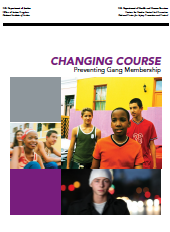The consequences of gangs — and the burden they place on the law enforcement and public health systems in our communities — are significant. People who work in the fields of public health and public safety know that efforts to address the problem after kids have already joined gangs are not enough. To realize a significant and lasting reduction in youth gang activity, we must prevent young people from joining gangs in the first place.
Here are some things we know from the research:
- The large majority of kids who join a gang do so at a very early age — between 11 and 15 years old.
- Joining a gang is part of a life course; therefore, it is important to understand the risk factors for children starting at birth.
- Strong families are a major protective factor in preventing kids from joining gangs.
- Very early prevention efforts — including programs focusing on low-income pregnant mothers and families with young children — show promising results.
- Communities — not just classrooms — should be regarded as a valuable resource for reaching kids at risk of joining gangs.
- Girls join gangs in large numbers; therefore, some prevention efforts should address gender-specific concerns.
NIJ and the Centers for Disease Control and Prevention (CDC) formed a partnership to publish a book, Changing Course: Preventing Gang Membership. Written by some of the nation’s top criminal justice and public health researchers, Changing Course offers evidence-based principles that can halt the cascading impact of gangs on youth, families, neighborhoods and society at large. The goal of the book (and a separate executive summary publication) is to help policymakers who make decisions about the best use of taxpayer dollars — and practitioners who work in the trenches, such as law enforcement officers, teachers and community services providers — understand what the research says about keeping kids out of gangs.
Each chapter includes an In the Spotlight section, which highlights interviews with practitioners who describe their personal experiences. Each chapter also includes a discussion of policy implications.
The Executive Summary (pdf, 20 pages) offers a glimpse into the full book and is designed especially for policymakers and other professionals who may want an overview of major take-away points that the researchers explore in each chapter.
Read summaries of and download individual chapters:
- Introduction: NIJ and CDC’s Overview of the Issue and the Book
- Why Is Gang-Membership Prevention Important?
- The Attraction of Gangs: How Can We Reduce It?
- What Is the Role of Public Health in Gang-Membership Prevention?
- What Is the Role of Police in Preventing Gang Membership?
- How Should We Identify and Intervene With Youth at Risk of Joining Gangs?
- What Should Be Done in the Family to Prevent Gang Membership?
- What Can Schools Do to Help Prevent Gang-Joining?
- What Should Be Done in the Community to Prevent Gang-Joining?
- How Can We Prevent Girls From Joining Gangs?
- Race and Ethnicity: What Are Their Roles in Gang Membership?
- Program Evaluation: How Do We Know If We Are Preventing Gang Membership?
- Conclusion: An Invitation From NIJ and CDC to Contribute to Gang-Joining Prevention
About This Article
This article presents a chapter summary from the joint National Institute of Justice and Centers for Disease Control and Prevention publication Changing Course: Preventing Gang Membership (pdf, 166 pages). Changing Course features chapters written by some of the nation’s top criminal justice and public health researchers. The volume was edited by Thomas R. Simon, Centers for Disease Control and Prevention, Nancy M. Ritter, National Institute of Justice, Reshma R. Mahendra, Centers for Disease Control and Prevention.


